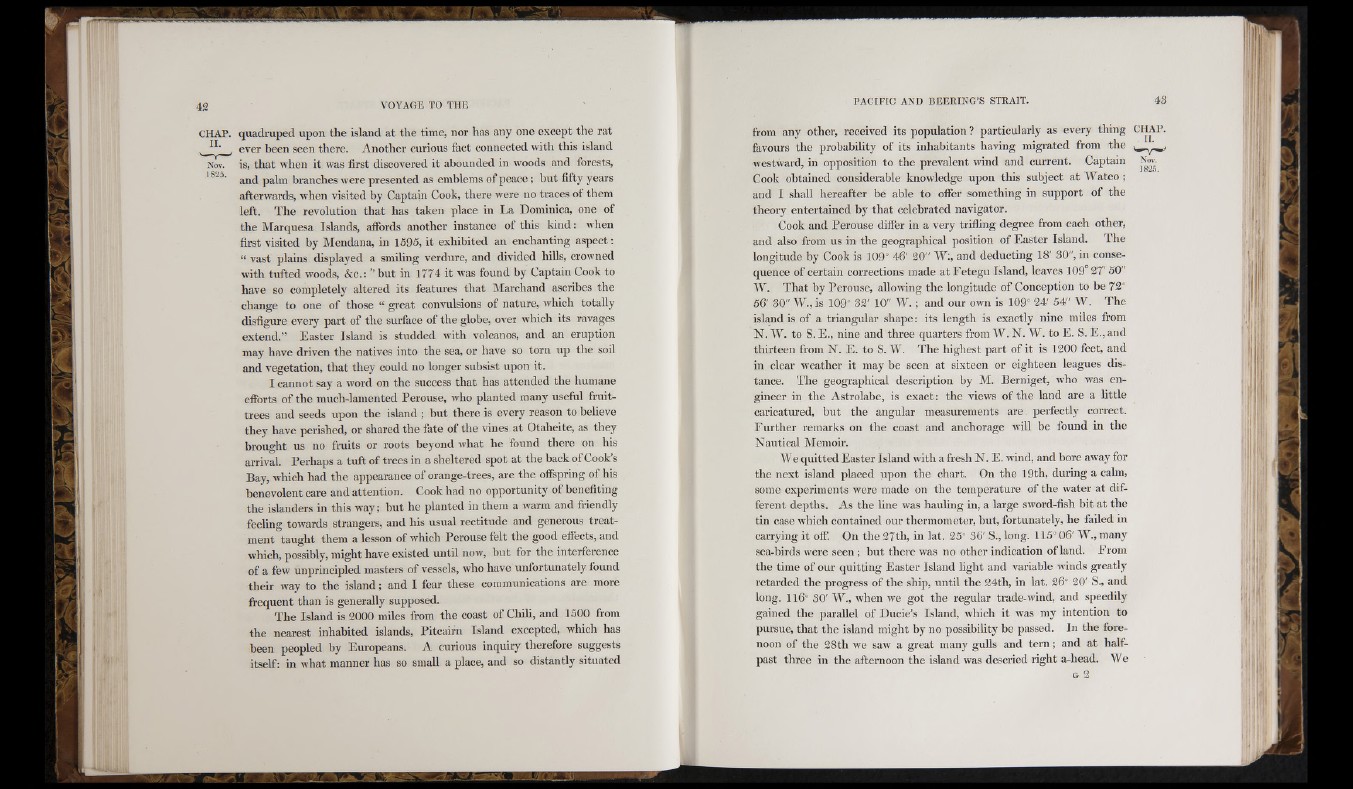
CHAP. q u a d ru p ed upo n th e island a t th e time, nor has any one e x cep t th e ra t
ever been seen there. Another curious fact connected with this island
is, that when it was first discovered it abounded in woods and forests,
and palm branches were presented as emblems of peace; but fifty years
afterwards, when visited by Captain Cook, there were no traces of them
left. The revolution that has taken place in La Dominica, one of
the Marquesa Islands, affords another instance of this kind: when
first visited by Mendana, in 1595, it exhibited an enchanting aspect;
“ vast plains displayed a smiling verdure, and divided hills, crowned
with tufted w'oods. See.: ” but in 1774 it was found by Captain Cook to
have so completely altered its features that Marchand ascribes the
change to one of those “ great convulsions of nature, which totally
disfigure every part of the surface of the globe, over which its ravages
extend.” Easter Island is studded with volcanos, and an eruption
may have driven the natives into the sea, or have so torn up the soil
and vegetation, that they could no longer subsist upon it.
I cannot say a word on the success that has attended the humane
efforts of the much-lamented Perouse, who planted many useful fruit-
trees and seeds upon the island ; but there is every reason to believe
they have perished, or shared the fate of the vines at Otaheite, as they
brought us no fruits or roots beyond what he found there on his
arrival. Perhaps a tuft of trees in a sheltered spot at the back of Cook’s
Bay, which had the appearance of orange-trees, are the offspring of his
benevolent care and attention. Cook had no opportunity of benefiting
the islanders in this way; but he planted in them a warm and friendly
feeling towards strangers, and his usual rectitude and generous treatment
taught them a lesson of which Perouse felt the good effects, and
which, possibly, might have existed until now, but for the interference
of a few unprincipled masters of vessels, who have unfortunately found
their way to the island; and I fear these communications are more
frequent than is generally supposed.
The Island is 2000 miles from the coast of Chili, and 1500 from
the nearest inhabited islands, Pitcairn Island excepted, which has
been peopled by Europeans. A curious inquiry therefore suggests
itself; in what manner has so small a place, and so distantly situated
from any other, received its population ? particularly as every thing CHAP.
favours the probability of its inhabitants having migrated from the
westward, in opposition to the prevalent wind and current. Captain Nov.
Cook obtained considerable knowledge upon this subject at YEateo ;
and I shall liereafter be able to offer something in support of the
theory entertained by that celebrated navigator.
Cook and Perouse differ in a very trifling degree from each other,
and also from us in the geographical position of Easter Island. The
longitude by Cook is 109° 46' 20" YA:, and deducting 18' 30", in consequence
of certain corrections made at Fetegu Island, leaves 109° 27' 50"
YY'“. That by Perouse, allowing the longitude of Conception to be 72°
56' SO" YY"., is 109° 32' 10" YV.; and our own is 109° 24' 54" YA. The
island is of a triangular shape; its length is exactly nine miles from
N. YA. to S. E., nine and three quarters from YA. N. YA. to E. S. E., and
thirteen from N . E. to S. YYY The highest part of it is 1200 feet, and
in clear weather it may be seen at sixteen or eighteen leagues distance.
The geographical description by M. Berniget, who was engineer
in the Astrolabe, is exact; the views of the land are a little
caricatured, but the angular measurements are perfectly correct.
Further remarks on the coast and anchorage will be found in the
Nautical Memoir.
YVe quitted Easter Island with a fresh N. E. wind, and bore away for
the next island placed upon the chart. On the 19th, during a calm,
some experiments w-ere made on the temperature of the water at different
depths. As the line was havding in, a large sword-fish bit at the
tin case which contained our thermometer, but, fortunately, he failed in
carrying it off. On tlie 27th, in lat. 25° 36' S., long. 115° 06' YY"., many
sea-birds were seen ; but there was no other indication of land. From
tlie time of our quitting Easter Island light and variable winds greatly
retarded the progress of the ship, until the 24th, in lat. 26° 20' S., and
long. 116° SO' YV., when we got the regular trade-wind, and speedily
gained the parallel of Ducie’s Island, which it was my intention to
pursue, that the island might by no possibility be passed. In the forenoon
of the 28th we saw a great many gulls and tern ; and at h<alf-
past three in the afternoon the island was descried right a-head. YV e
G 2
:■ i i